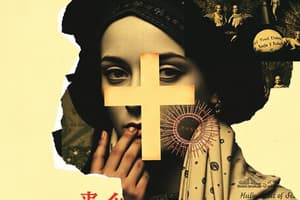Podcast
Questions and Answers
Nestorius believed that Mary should be called theotokos, or mother of God.
Nestorius believed that Mary should be called theotokos, or mother of God.
False (B)
The teachings of Nestorius were declared heretical at the ecumenical synod of Ephesus in AD 431.
The teachings of Nestorius were declared heretical at the ecumenical synod of Ephesus in AD 431.
True (A)
Nestorius's interpretation stated that the humanity and divinity of Jesus existed as separate entities.
Nestorius's interpretation stated that the humanity and divinity of Jesus existed as separate entities.
True (A)
The Nestorian Church was primarily established in India and China.
The Nestorian Church was primarily established in India and China.
When Jesus raised Lazarus from the dead, he demonstrated his human nature.
When Jesus raised Lazarus from the dead, he demonstrated his human nature.
Eutyches taught that Jesus's human and divine natures fused to create a single new nature.
Eutyches taught that Jesus's human and divine natures fused to create a single new nature.
The Synod of Chalcedon established that Jesus was only divine after the incarnation.
The Synod of Chalcedon established that Jesus was only divine after the incarnation.
Almost 500 bishops from various regions were present at the Synod of Chalcedon.
Almost 500 bishops from various regions were present at the Synod of Chalcedon.
The faith of Eutyches was accepted by the universal Church after the decisions of the Chalcedon Synod.
The faith of Eutyches was accepted by the universal Church after the decisions of the Chalcedon Synod.
The phrase 'he became human without change of nature' was added to the creed after the Chalcedon synod.
The phrase 'he became human without change of nature' was added to the creed after the Chalcedon synod.
Study Notes
Virgin Mary and Theotokos
- Virgin Mary, mother of Jesus, became an object of veneration and was addressed as "Theotokos," meaning "Mother of God."
- Worship of Mary grew over time, emphasizing her significance in Christian theology.
Nestorius and His Opposition
- Nestorius, Bishop of Antioch, opposed the term "Mother of God," arguing that Mary only gave birth to Jesus, not God.
- He taught the coexistence of Jesus' human and divine natures, exemplified by Jesus’ actions such as weeping and performing miracles.
Nestorius’ Teachings
- Presented a dual personality perspective of Jesus:
- Human nature: Seen when Jesus wept or slept.
- Divine nature: Evident when Jesus raised Lazarus or calmed the storm.
Ecumenical Synod of Ephesus
- The ecumenical synod was convened in AD 431 by Emperor Theodosius II to address Nestorius' beliefs.
- The synod declared Nestorius' teaching a heresy and affirmed Jesus Christ as fully human and fully divine.
Aftermath of the Synod
- Nestorius and his followers refused to abandon their beliefs following the synod's declaration.
- The emperor ordered their banishment from the Roman Empire.
Formation of the Nestorian Church
- Exiled followers established the Nestorian Church in Persia and Syria.
- The church engaged in significant missionary work, reportedly reaching as far as India and China.
Modern Legacy
- The current Chaldean Syrian Church in Thrissur is part of the Assyrian Church, which stems from the Nestorian tradition.
Eutyches and The Monophysite Controversy
- Eutyches, a monk priest from Constantinople, proposed that Jesus' human and divine natures fused into one new nature.
- This belief contradicts the Nicene Affirmation, which states Jesus is both fully human and fully divine.
- Eutychian belief leads to denial of Jesus being completely human and completely divine, categorized as Monophysite Faith.
Chalcedon and The Fourth Ecumenical Synod
- In AD 451, a synod was convened in Chalcedon to address the heresy, prompted by Leo I, Bishop of Rome.
- The synod included nearly 500 bishops from Constantinople, Alexandria, Jerusalem, and Antioch.
- The existing creeds from Nicaea and Constantinople were reaffirmed, rejecting Eutychian views.
Key Findings of the Synod
- The synod established that Jesus Christ possesses two natures—human and divine—that are undivided and indistinguishable at all times.
- To clarify this belief, the phrase “he became human without change of nature” was added to the creed.
- Formal documentation confirmed the nature of faith that post-incarnation, Jesus is fully human and fully divine.
Aftermath of the Synod
- Following the Chalcedon Synod, the universal Church became divided into factions.
- One faction accepted the decisions of the Chalcedon Synod, while the other rejected them, leading to ongoing theological conflicts.
Studying That Suits You
Use AI to generate personalized quizzes and flashcards to suit your learning preferences.
Description
Explore the theological debate surrounding the Virgin Mary and her title as the Theotokos, Mother of God. Understand Nestorius's opposition to this veneration and his teachings regarding the nature of Christ. This quiz delves into early Christian doctrine and the complexities of humanity and divinity.

